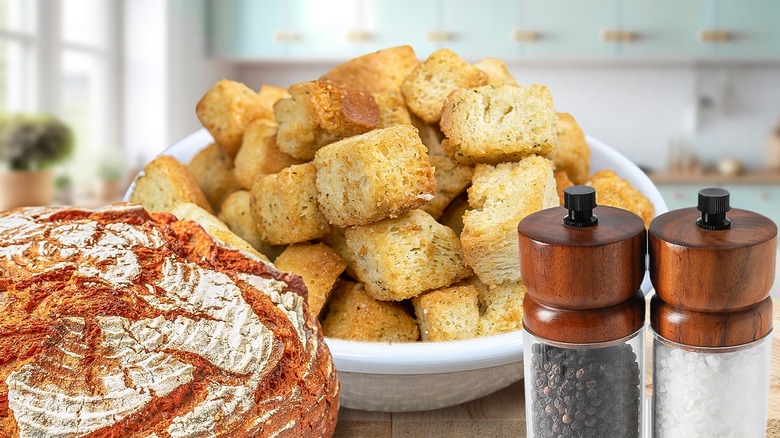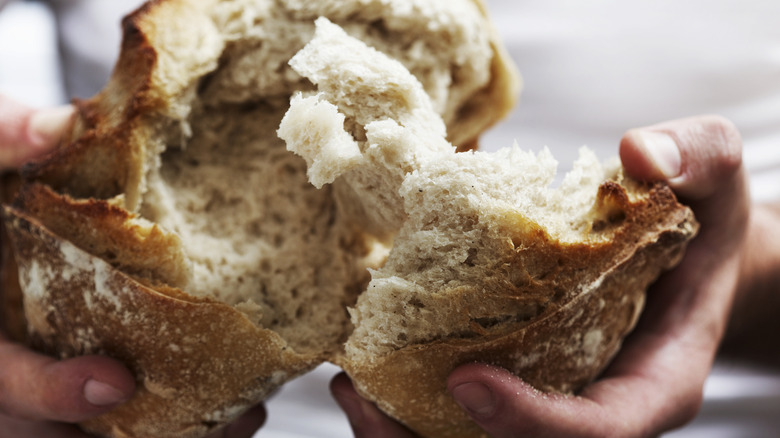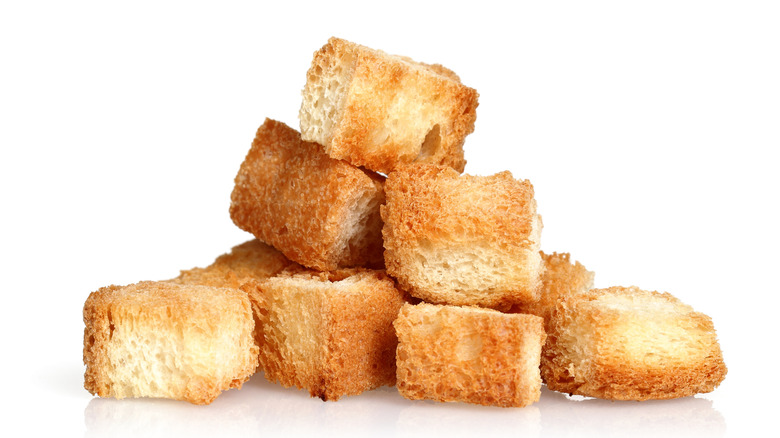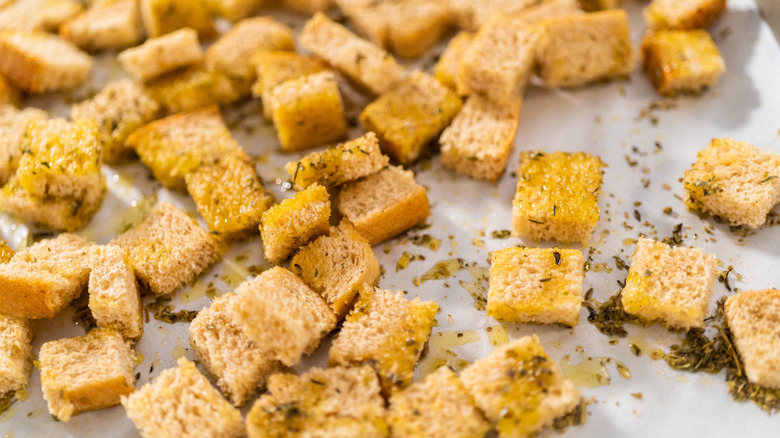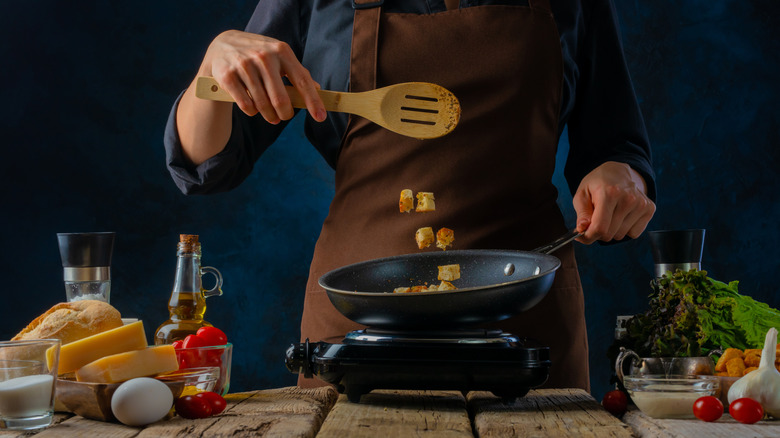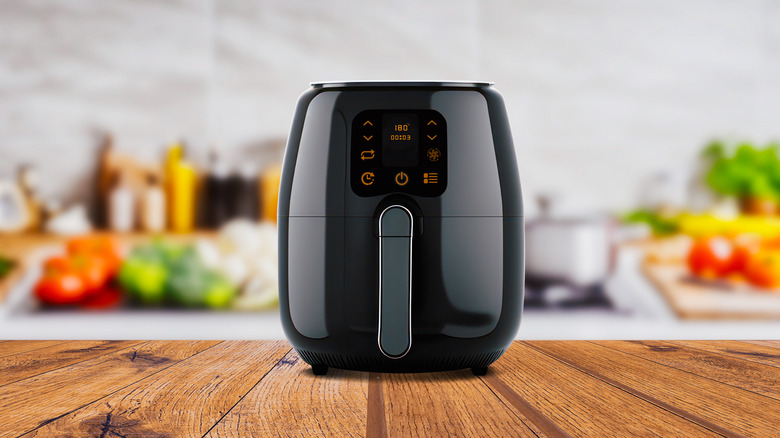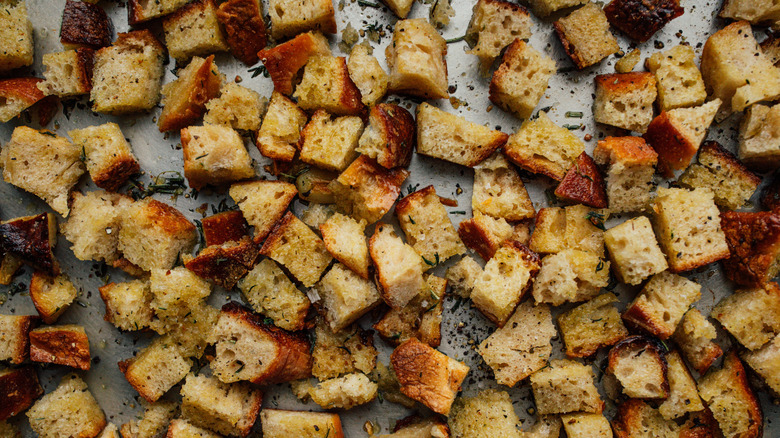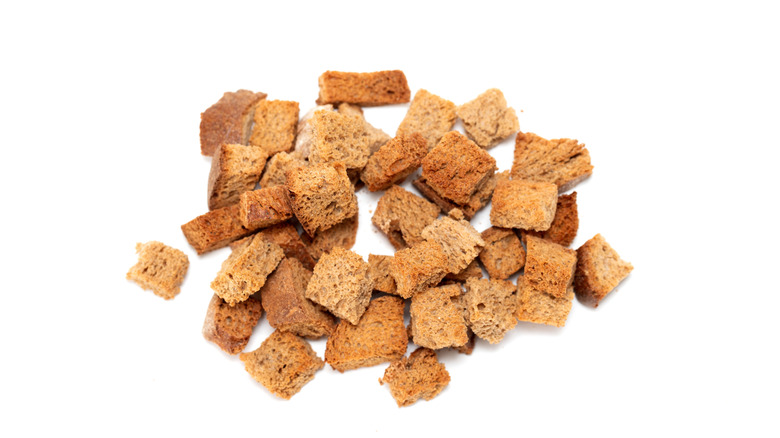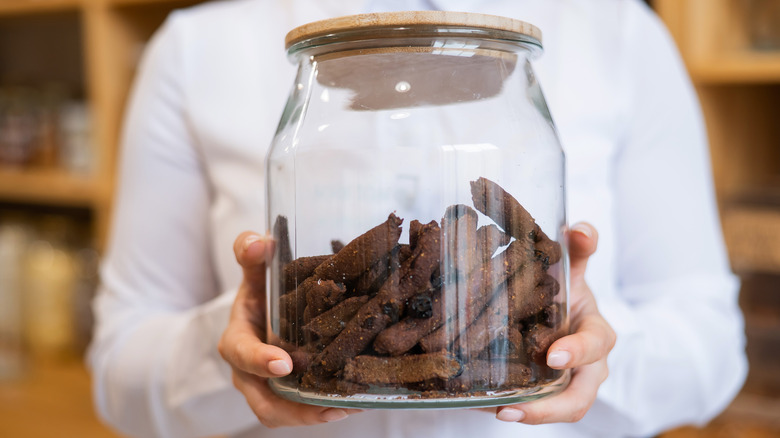8 Absolute Best Tips For Making Homemade Croutons
Store-bought croutons are convenient for adding a delightful crunch to everything from your favorite salads to creamy soups and rustic stuffing recipes. While they may be the easy alternative, when it comes to taste, homemade is best. Not only are homemade croutons a fresher, more flavorful alternative, making them yourself allows you to customize them to suit your tastes and the dish you'll be adding them to. The contents of your spice rack are your only limitation.
Loosely translated, the word crouton means crust in French. It's a nod to the thin baguette slices that French cooks coated with butter or oil and baked. They've evolved into crispy bits of bread that add a crunchy layer of flavor to anything they're added to. Making croutons at home is simple, if you know the common pitfalls to avoid. These tips will turn you into a crouton baking machine with perfect results every time. Homemade croutons are also a wonderful way to upcycle that stale loaf of bread hanging out in your pantry.
Choose a sturdy bread
Croutons should be a toothsome blend of crunch and airiness. One way to set yourself up for success in achieving this delicate balance when making croutons at home is to choose the right bread. You might think any bread can be toasted and used as a crouton, but not all bread is crouton-worthy.
Crusty breads make it easy to attain the ideal crouton bite. Their hardy texture allows them to crisp without falling apart. While you can make croutons with fresh bread, stale bread is better. Don't mistake stale bread for bread that's moldy. Stale bread should show no signs of mold. It's typically harder and dry, which is why it's perfect for making croutons.
Avoid bread that is too soft or sliced too thinly. These breads may not hold up well to being toasted. Use bread that you can cut or tear into pieces that are at least one inch in size so they're large enough to maintain their crunchy texture when they're baked and when they're added to a salad or soup.
Make sure they're about the same size
Croutons are simple to prepare, but your success is in the details when making them. One seemingly insignificant misstep can leave you with a mess of burnt or undercooked croutons if you're not careful. Whether you're using your best kitchen knife to cut bread for croutons or tearing them by hand for a more rustic look, there's one thing you should pay close attention to, size.
It doesn't matter if you prefer your croutons small and refined or on the hefty side, they should all be similar in size before you toast them. This might seem like a minor detail, but not paying close attention to their size can lead to crouton chaos.
Cutting or tearing your croutons uniformly will make sure they bake evenly and are all consistent in texture and in flavor. If you put croutons that are drastically different in size on the same baking sheet, you may have a hard time getting them all cooked evenly. If you remove them as soon as the smaller croutons are done, the big croutons will be undercooked. Waiting until the larger croutons are fully toasted will likely lead to the smaller pieces burning.
Season them well
Once you've chosen the right bread for your croutons and broken it down into pieces, it's time to season them. Toasted bread is delicious on its own, but everything is better when it's seasoned well. Salt and pepper are a good start, but for the most flavorful croutons reach for herbs, spices, and more from your pantry and your fridge.
To season croutons, drizzle them with olive oil. It will make it easier for other seasonings to stick to the croutons. Start with a generous sprinkle of salt and pepper. These should be considered your base seasonings, and you can add additional herbs, spices, and more for added layers of flavor. Once they're seasoned to your liking, toss them to ensure they're evenly coated before toasting them.
While tried and true spices like garlic powder, paprika, thyme, and rosemary will add a delicious depth of flavor, don't be afraid to look outside your spice drawer for options that may be a bit out of the ordinary. One unexpected ingredient that will elevate your croutons is anchovies. Simply cook the anchovies in olive oil until they melt into the oil then pour the oil over your croutons before you toast them.
Cook them on the stovetop
Baking croutons in the oven might be the norm, but you can also make crispy, flavorful croutons in a skillet on the stovetop. Using the oven has its advantages. It's a hands-off method that allows you to work on other tasks while your croutons toast, but it's also easier to burn them in the oven. Out of sight, out of mind is not necessarily a good thing in the kitchen.
Stovetop croutons are faster to prepare. There's no waiting for the oven to preheat. You can add them to a hot pan and have salad-ready croutons in just a few minutes. Cooking them on the stovetop also makes it easier for you to cook the croutons exactly to your liking. You can more easily monitor them as they toast and brown.
To make stovetop skillet croutons, break out a skillet and add oil or butter. Once the pan is hot, add in your bread and cook, tossing it frequently to ensure each crouton is evenly coated in the oil, until golden brown. Remove the croutons from the skillet and place them on a paper towel to drain before using them. One downside of stovetop croutons is that they don't maintain their crispness as long as croutons toasted in the oven.
Air fry them
There are numerous ways to use an air fryer in the kitchen. Since they've skyrocketed in popularity, we've all become reliant on our air fryers to cook everything from roast beef to spicy shrimp, to jalapeño poppers without having to turn on the oven.
If you're a fan of croutons, you can add them to the list of foods you can prepare in your trusty air fryer. It's a quick and efficient way to create perfectly crispy croutons in less time and with less oil than traditional methods. The air fryer's circulating heat will ensure even browning and give you crunchy croutons in a fraction of the time.
You'll prepare your croutons very much the same way you'd prepare them in the oven or on the stovetop. Toss them in olive oil or butter, but just enough to lightly coat them, along with your seasonings of choice, then add them in one even layer to your air fryer basket. Cook your croutons between 350 degrees and 400 degrees Fahrenheit for five to six minutes until crunchy.
Maintain crowd control
When you hear the term crowd control, making croutons is probably not the first thing that comes to mind, but it's an important consideration in preparing croutons properly. No matter which method you're using to prepare your croutons, carefully managing the way they are spaced is key.
Croutons benefit from direct contact with the bottom of a hot baking sheet or skillet. They also rely on the hot air that circulates around them. When they're too close together or piled on top of each other, all of the croutons won't have contact with the pan or skillet. They also won't reap the benefits — crispy sides — of having space between them for the hot air to circulate. Instead, steam will build up in the pan and your croutons will be soft instead of crisp.
Whether you're preparing them in a skillet, on a baking sheet, or in your air fryer, leave a little space between your croutons for best results. It's better to cook them in smaller batches than try to cook too many all at once. This is why most recipes instruct cooks to spread the croutons in one even layer.
Don't over crisp them
We've all been there, biting into a crouton so hard and sharp that it cuts the roof of your mouth and takes extra effort to chew. This is the opposite of what a crouton should be. Crisp, yes, but not so much that it injures you or feels like you're chewing gravel. Unfortunately, over-crisping croutons is easy to do. If you're preparing them in the oven, waiting even a minute too long to remove them can end in disaster. You can even overdo it on the stovetop if you don't stir them frequently enough. The air fryer is a slightly gentler method, but if you get the timing wrong you can overcook them there, as well.
There are fortunately steps you can take to make sure you don't over crisp your croutons. The easiest is to check them frequently as they cook. You can take them off the heat or remove them from the oven before they're fully crisp. If you leave them on the baking sheet or in the skillet, the residual heat stored in the pan will continue to cook them.
Start a timer when you're cooking your croutons that's a minute or two less than what your recipe calls for. You can check the croutons and use your judgement as to whether you should continue cooking them.
Store them properly
Proper storage will make sure your homemade croutons stay fresh and crisp. If they're stored properly they can last up to two weeks, which gives you lots of time to add them to your favorite salads or soups. When it comes to storing them properly, your focus should be on two things — cool and dry.
Once your croutons are done cooking, you might be tempted to package them for storage immediately, but that can be a big mistake. You must give your croutons time to cool completely before you store them. For best results, store your croutons in a resealable, airtight plastic bag or container. If you add them to your storage container while they're still warm from the oven, steam will collect in the bag or container, which will soften the croutons or even make them soggy. It's also important to keep your croutons dry. Moisture, even in the form of humidity, will not only soften your croutons, but it can also cause them to mold.
You can also freeze homemade croutons to use later. Once they're cool, put them into a resealable plastic bag and pop the bag in the freezer. They'll last four to six weeks in the freezer.
